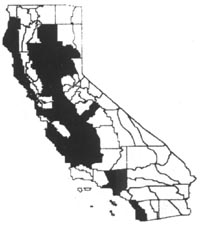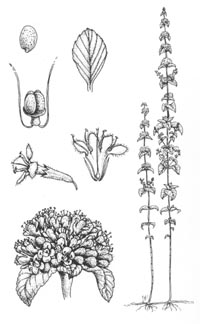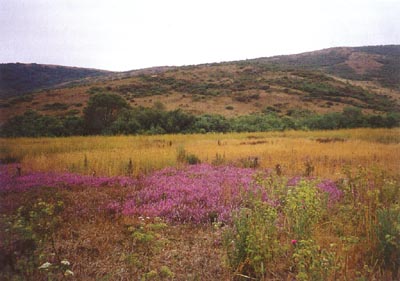|
Mentha pulegium
|
|
|
|
Scientific name
|
Mentha pulegium
|
|
Additional name information:
|
L.
|
|
Common name
|
pennyroyal
|
|
Synonymous scientific names
|
Pulegium vulgar
|
|
Closely related California natives
|
1
|
|
Closely related California non-natives:
|
3
|
|
Listed
|
CalEPPC List B,CDFA nl
|
|
By:
|
Peter Warner
|
|
Distribution
|
|
HOW DO I RECOGNIZE IT?
Distinctive features:
|
Pennyroyal (Mentha pulegium) is a
perennial mint with a variable habit, ranging from low-growing, spreading plants
to lanky, upright subshrubs. The pale or deeper pink, blue, or violet flowers
are clustered in dense whorls at the upper nodes. The plant has a powerful and
pungent minty odor. The stems are square in cross-section, ascending from
rhizomes. Branches and simple leaves are opposite on stems. Unlike many mints,
the flowers are not strongly bilateral, but only slightly two-lipped.
åÊ
|
|
Description:
|
| Lamiaceae. Perennial herb growing from rhizomes. Stems: subglabrous to short-hairy, decumbent to ascending, branched, 4-angled, 4-35 in (10-90 cm) high. Leaves: generally 0.25-1 in (1-2.5 cm) long, reduced upward, lower leaves petioled, those higher on stems subsessile; blade narrowly ovate to elliptic, base tapered to obtuse, leaf tip rounded, margin entire to finely serrate, lower surface short-hairy. Inflorescence: collectively spike- or panicle-like, individually axillary and head-like, subtended by reflexed leaves or smaller, leaf-like bracts. |
|
Flowers: calyx 0.1-0.25 in (2-4.5 mm),
subradial; 5 lobes (teeth) ciliate, lower 3 subulate, upper 2 shorter, wider;
corollas 0.25-0.38 in (4-8 mm), violet to lavender, pink or blue, often paler
with age, upper lip notched, lower three-lobed; 4 stamens, subequal, exceeding
corolla. Carpels: ovary superior, 4-lobed, 2 chamber, each with 2 ovules; 1
style arising from junction of ovary lobes; 2 stigmas, unequal. Fruits: 4
nutlets, seeds 0.07 in (0.75 mm), pale brown, ovoid to oblong (Hickman 1993,
Tutin et al. 1976).
åÊ
|
|
WHERE WOULD I FIND IT?
|
Although considered uncommon in much of
California (Hickman 1993), pennyroyal occurs in the Sierra foothills, Central
Valley, and most coastal counties from the Mexican border to Oregon. It is
common as an obligate wetland indicator species in seasonally inundated soils of
valley bottomlands, usually below 1,640 feet (500 m) elevation (Reed 1988). It
is locally abundant in the San Francisco Bay region, including moist meadows and
vernal pools of the Laguna de Santa Rosa floodplain (Sonoma County), along
roadsides, and on the perimeters of freshwater and brackish marshes (e.g.,
Estero Americano, Petaluma River).
Pennyroyal grows in vernally flooded or seasonally wet areas:
seeps, streamsides, vernal pools and swales, marshes, and ditches (Hickman 1993;
Warner pers. observation). It appears to grow predominantly in heavy clay or
silty soils. The plant flourishes on frequently disturbed sites, such as heavily
grazed pastures, or sites with milder disruptions, such as seasonal depositions
of silt and organic debris. While tolerant of some alkalinity, seasonal drought,
and warm temperatures, optimal development of pennyroyal appears to occur where
other vegetation shades stems and rhizomes (underground stems) and contributes
to sustained moderation of soil moisture and temperature.
åÊ
|
|
WHERE DID IT COME FROM AND HOW IS IT SPREAD?
|
Pennyroyal is native to Ireland, across
southern and central Europe, to the Ukraine (Tutin et al. 1976). A European folk
name for the plant is grows-in-the-ditch (Polonin 1969). Repeatedly introduced
into North America since European settlement, pennyroyal is now found
naturalized in wildlands throughout the world (Grieve 1959). It can spread via
seed dispersal or fragmentation of stolons. Dispersal of seeds or stems by water
and/or animals has contributed to its successful establishment beyond domestic
gardens. It has hairy calyces containing nutlets that are well adapted to
dispersal by sticking to animal fur or wool. Nutlets are also spread via mud on
hooves or may be ingested by animals and deposited elsewhere. Humans have
contributed to the dispersal and subsequent establishment of pennyroyal in
non-cultivated areas by propagating and growing it for its purported medicinal
or herbal values (Duke 1985). It is also spread by vehicles traveling from
infested to non-infested areas. Daughter plants develop along stolons, spreading
it vegetatively locally and forming new patches if the stolons are fragmented,
as by cultivation (Parson 1992).
åÊ
|
|
WHAT PROBLEMS DOES IT CAUSE?
|
Although pennyroyal is considered
moderately invasive in wetlands (CalEPPC 1996), its ecological impacts are not
well documented. It clearly prospers in habitats that were once dominated by
native plants, suggesting that it may have displaced some species. In
particular, the flora of vernal pools may have suffered loss of habitat through
the introduction of pennyroyal. However, its capacity to displace native plant
species is uncertain, especially given the frequent disturbance of habitats that
it invades. Pennyroyal can be a nuisance for ranchers, since livestock can be
poisoned by this unpalatable rangeland weed (Fuller and McClintock 1986).
åÊ
|
|
HOW DOES IT GROW AND REPRODUCE?
|
Inconspicuous in spring during vegetative growth, pennyroyalÛªs flowering peak occurs in summer. Timing of flowering appears correlated with soil moisture levels or diurnal maximum temperatures, with populations on drier and warmer sites flowering earlier. Earliest blooming starts in June, with plants in milder or wetter (e.g., coastal, estuarine) sites often flowering through November. Seeds are produced abundantly from the numerous and dense inflorescences from late spring through fall. By late autumn the flowering stems have dried, but seed heads may remain intact through the winter. Water and stock animals and ungulates are principal vectors (Parsons 1992); little is known about the role of granivores in seed dispersal.
Seedlings appear in heavy, silty clays once pools of water formed in winter have almost dried (Warner, pers. observation). Seeds germinate after exposure to alternating temperatures, and they have a light requirement for germination. A seedbank usually develops. Seeds can germinate in water, and seedlings survive readily even in areas with prolonged shallow inundation (Parsons 1992). Seedlings and rhizomes (underground stems) both develop fibrous, net-like root systems (Parsons 1992).
Pennyroyal is a ground-hugging perennial, with herbaceous above-ground tissues regenerating in spring and dying in late fall in established plants. Established plants overwinter as rhizomes just below the soil surface, with roots and flowering stems growing from conspicuous nodes in mid-spring. These rhizomatous ramets may persist for several years.
|
Shoots often assume a decumbent, nodal rooting habit in drying pools, suggesting that this may be a mechanism for optimizing water uptake during growth. Shoot and leaf production begin as water recedes in spring, and the most vigorous growth occurs in late spring and early summer. Once soils have dried, inflorescences are formed on most shoot tips (Bailey 1964).
|
(click on photos to view larger image)
|
|
|
HOW CAN I GET RID OF IT?
|
Considering the shortage of scientific
literature about Mentha pulegium, any effort to document control
efforts would probably yield important management information. Monitoring should
include data collection on plants and evaluation of various control
alternatives, as well as compilation of environmental data. Subsequent reporting
of results, however informal, would significantly increase knowledge about the
management of pennyroyal. Experiments designed to assess the effectiveness of
various control alternatives would benefit management strategies for habitat
preservation or restoration.
åÊ
|
|
Physical control:
|
Mechanical methods: PennyroyalÛªs brittle
stems and propensity for resprouting probably rule out soil tilling or hand
pulling as effective control methods. Late spring or early summer mowing,
repeated over several years, may weaken plants by depleting photosynthetic
reserves. Definitive research data is needed.
Prescribed burning: This may be a viable control method,
although high soil moisture levels in most pennyroyal habitats may limit the
effectiveness of burning. In habitats where the timing of fire would not harm
native species, well designed experiments to investigate the effects of various
burn prescriptions are needed.
åÊ
|
|
Biological control:
|
Insects and fungi: No research has been
conducted on biological control agents for pennyroyal.
Grazing: Control by livestock grazing appears unlikely.
Pennyroyal is unpalatable as forage for cows or sheep and sometimes causes
gastrointestinal irritation when ingested (Parsons 1992; Warner, pers.
observation).
åÊ
|
|
Chemical control:
|
Seedlings are susceptible to
ester-formulated 2,4-D. Mature plants are resistant to 2,4-D, but can be killed
with label-recommended concentrations of glyphosate or triclopyr (Parsons 1992).
However, these herbicides pose hazards to non-target species in wetlands,
including desirable plants, animals, and microorganisms. Triclopyr is not
currently registered for use in wetlands. Broadcast applications would not be
acceptable in many situations. Cut-stem applications would be extremely
labor-intensive, even if effective in reducing environmental contamination to an
acceptable level.
åÊ
|




